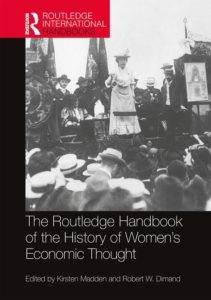Routledge Handbook of the History of Women’s Economic Thought
ed. by Kirsten Madden, Robert W Dimand
Routledge, September 21, 2018
466 Pages – 8 B/W Illustrations
ISBN 9781138852341 – CAT# Y176819
Book Page on the Publisher’s website
The marginalization of women in economics has a history as long as the discipline itself. Throughout the history of economics, women contributed substantial novel ideas, methods of inquiry, and analytical insights, with much of this discounted, ignored, or shifted into alternative disciplines and writing outlets.
This handbook presents new and much-needed analytical research of women’s contributions in the history of economic thought, focusing primarily on the period from the 1770s into the beginning of the 21st century. Chapters address the institutional, sociological and historical factors that have influenced women economists’ thinking, and explore women’s contributions to economic analysis, method, policies and debates. Coverage is international, moving beyond Europe and the US into the Arab world, China, India, Japan, Latin America, Russia and the Soviet Union, and sub-Saharan Africa. This new global perspective adds depth as well as scope to our understanding of women’s contribution to the history of economic thought.
The book offers crucial new insights into previously underexplored work by women in the history of economic thought, and will prove to be a seminal volume with relevance beyond that field, into women’s studies, sociology, and history.
Table of contents
Introduction
Part I Beginning Prior to 1850
Chapter 1 Indian Women’s Agency through Indian Women’s Literature Sheetal Bharat
Chapter 2 English Women’s Economic Thought in the 1790s: Domestic Economy, Married Women’s Economic Dependence, and Access to Professions Joanna Rostek
Chapter 3 British Women on the British Empire Janet Seiz
Chapter 4 Harriet Taylor Mill, Mary Paley Marshall and Beatrice Potter Webb: Women Economists and Economists’ Wives Virginie Gouverneur
Chapter 5 Japanese Women’s Economics, 1818-2005 Aiko Ikeo
Part II Beginning in the Late 19th Century
Chapter 6 Contextualizing women’s economic thought in late Imperial Russia and in the early years of Revolution: 1870-1920 Anna Klimina
Chapter 7 Is Equal Pay Worth It? Beatrice Potter Webb’s, Millicent Garrett Fawcett’s and Eleanor Rathbone’s changing arguments Cléo Chassonnery- Zaïgouche
Chapter 8 The Economic Thought of the Women’s Co-Operative Guild Kirsten Madden and Joe Persky
Chapter 9 Anecdotes of Discrimination: Barriers to Women’s Participation in Economic Thought During the Late Nineteenth and Early Twentieth Centuries Kirsten Madden
Chapter 10 The Point is to Change It: Three Lives of Applied Marxism Zoe Sherman
Part III Beginning in the early 20th Century
Chapter 11 Women Economists in the Academy: Struggles and Strategies, 1900-1940 Mary Ann Dzuback
Chapter 12 Daughters of Commons: Wisconsin Women and Institutionalism Marianne Johnson
Chapter 13 Women Economists of Promise? Six Hart, Schaffner and Marx Prize Winners in the Early Twentieth Century Kirsten Madden
Chapter 14 Early Women Economists at Columbia University: Contributions in the Struggle for Labor Protection in the Lochner Era Clara Elisabetta Mattei
Chapter 15 Chinese Economic Development and Chinese Women Economists: A Study of Overseas Doctoral Dissertations Yue Xiao
Part IV Spanning the Mid-20th Century
Chapter 16 Austrian School Women Economists Giandomenica Becchio
Chapter 17 Placing women’s economics within Soviet economic discourse: 1920s – 1991 Anna Klimina
Chapter 18 Ursula Hicks’ and Vera Lutz’s contributions to development finance Lucy Brillant
Chapter 19 The Two Faces of Economic Forecasting in Italy: Vera Cao Pinna and Almerina Ipsevich Marcella Corsi and Giulia Zacchia
Part V Beginning mid-20th, Extending into the 21st Century
Chapter 20 The First 100 Years of Female Economists in Sub-Saharan Africa Lola Fowler and Robert W. Dimand
Chapter 21 Women Economists of the Arab Homeland Talia Yousef and Robert W. Dimand
Chapter 22 The Invisible Ones: Women at CEPAL (1948-2017) Rebeca Gómez Betancourt and Camila Orozco Espinel
Chapter 23 Women’s employment in the Informal Sector in Developing Countries: Contributions of Lourdes Beneria and Martha (Marty) Chen Farida Chowdhury Khan
Chapter 24 Women’s neoclassical models of marriage, 1972-2015 Shoshana Grossbard
